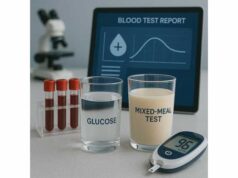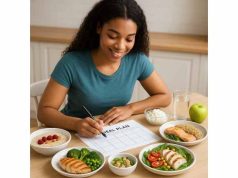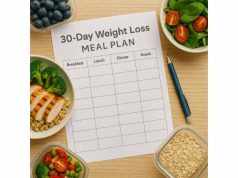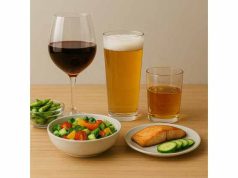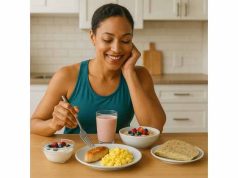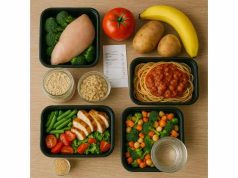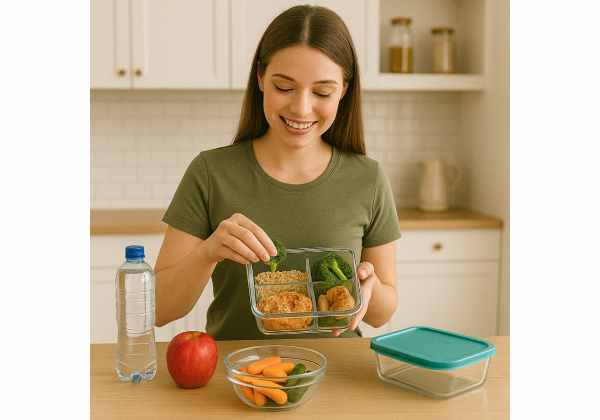
Lunch is where most weight-loss plans fall apart. Meetings run long, you miss the window to cook, and quick fixes creep in. The antidote is not a rigid meal plan—it is a repeatable system: packable recipes, smart grocery lists, and containers that make portion control automatic. In this guide you will learn how to build a satisfying weight-loss lunch in minutes, batch-prep a week of options, and keep a few grab-and-go backups for chaotic days. If you are still setting your calorie and macro targets, start with our plain-English overview of calorie budgeting and meal planning, then come back to lock in your lunch routine.
Table of Contents
- Why packable lunches work
- How to build a weight-loss lunch
- Make-ahead and batch prep
- Grab-and-go cold lunches
- Heat-and-eat lunch bowls
- Eating out or office cafeteria
- Common mistakes and fixes
- Frequently Asked Questions
Why packable lunches work
A good lunch does two jobs: it keeps afternoon hunger predictable and protects your calorie budget. Packable, make-ahead meals do both by controlling three levers that matter most for weight loss:
- Protein floor: 25–45 g per meal preserves muscle and tames cravings.
- High-volume plants: vegetables, fruit, and legumes provide bulk for few calories, which means generous portions with no mental gymnastics.
- Measured energy extras: small, deliberate amounts of dressing, oil, cheese, nuts, and sauces add flavor without silent calorie creep.
What “healthy lunch” really means for fat loss
- Enough protein to feel steady until dinner.
- Plenty of fiber and water from produce or legumes so the plate looks big.
- Carbs that fit your day: more around training or long afternoons; fewer when activity is low.
- Fats in teaspoons, not pours: drizzle, dot, or crumble—do not free-pour.
Why packing beats deciding at noon
- Decisions are expensive when you are hungry. A prebuilt lunch removes choice at the riskiest time of day.
- You control ingredients, portions, and hidden oils.
- Fridge-stable options survive meetings, traffic, or schedule slips.
A simple container strategy
- Three-compartment boxes: protein, produce, starch.
- Leak-proof jars for salads and soups.
- Small 2–4 tsp containers for oils, dressings, pesto, or nut butter.
Portion visuals you can use anywhere
- Protein: palm to palm-and-a-half (cooked 120–170 g chicken, fish, tofu; or 1 cup cottage cheese/Greek yogurt).
- Starch/legume: cupped hand (½–1 cup cooked rice, potatoes, lentils, beans, whole-grain pasta).
- Fats: thumb (1–2 tsp oil; 1 tbsp nuts or seeds).
- Veg/fruit: fill the rest of the container—think 2–3 cups.
If you want context on the whole journey (habits, movement, and pacing), skim our guide to healthy weight-loss basics and then put the lunch system below into action.
How to build a weight-loss lunch
Use this four-part formula to assemble any lunch quickly:
1) Protein anchor (25–45 g)
Pick one: grilled chicken or turkey, salmon or tuna, shrimp, extra-firm tofu, tempeh, seitan, beans and lentils, cottage cheese, Greek yogurt, high-protein wraps, or a simple shake on the side if your plate is light.
2) Produce pile (2–3 cups)
Aim for color and crunch. Raw mixes (romaine, cabbage, cucumbers, tomatoes), roasted trays (broccoli, carrots, onions, peppers), or quick “wet” options (salsa, pico, slaw) make lean proteins feel like a real meal.
3) Smart carbs (½–1 cup cooked)
Boiled potatoes, brown rice, barley, quinoa, whole-grain pasta, or legume pasta keep energy steady. If you train at lunch, move carbs before or after workouts.
4) Flavor finishers (2–4 tsp total)
Olive oil, tahini, pesto, nuts or seeds, feta, parmesan, pickled onions, citrus, herbs, hot sauce. Measure once, then drizzle or sprinkle.
Plug-and-play templates
- Big Salad + Protein: romaine + cabbage + tomatoes + cucumber, 150 g chicken or tofu, ½ cup chickpeas, 2 tsp olive oil and vinegar.
- Burrito Bowl: 120–150 g seared chicken or tempeh, ½ cup black beans, ½ cup rice, grilled peppers and onions, pico, 1–2 tsp crema or avocado.
- Mediterranean Box: 120 g salmon, tomato-cucumber salad, ½ cup farro, 2 tsp olive-lemon dressing, olives (measured).
- Protein-Pasta Lunch: whole-wheat or lentil pasta, turkey or lentil meat sauce, zucchini ribbons, parmesan (measured).
Make it fit your macros
If you are calibrating protein, carbs, and fats for your plan, review the quick ranges in our guide to macro ratios and fine-tune portions using the visuals above.
Five-minute backup lunches
- Tuna plate: tuna pouch + whole-grain crackers + pickles + sliced tomatoes + yogurt cup.
- Yogurt power bowl: Greek yogurt, berries, high-fiber cereal, chia; add a deli turkey roll-up on the side.
- Tofu snack box: baked tofu cubes, edamame, carrots, a fruit, and a small container of soy-ginger sauce.
Beverage rules of thumb
Water, sparkling water, black coffee, or unsweetened tea at lunch; save creamy or sugary drinks for rare occasions so calories stay on the plate where they satisfy you.
Make-ahead and batch prep
You can prep a week of lunches in 60–90 minutes with a sheet-pan, a pot, and a blender jar. The goal is to stock components you can mix and match, not seven identical boxes you grow to hate.
Step-by-step weekend flow
- Protein: roast 1–1.5 kg chicken breast or thighs (skin off after cooking), or bake a tofu/tempeh tray. Season half with a neutral rub (salt, pepper, garlic) and half with a bold blend (smoky paprika, cumin, coriander).
- Vegetables: fill a second tray with broccoli, peppers, onions, and carrots. Toss with 1–2 tbsp oil total; roast until browned.
- Carbs: boil a pot of potatoes or cook a grain (rice, barley, quinoa).
- Legumes: open and rinse 2–3 cans of beans or cook a quick pot of lentils.
- Sauces: blend a yogurt-herb sauce and a tahini-lemon dressing; portion in 2–4 tsp containers.
- Portion and label: pack 3–4 full lunches and store the rest as loose components for midweek variety.
Storage and safety
- Keep dressings and crunchy toppings separate until serving.
- Use shallow containers so food cools quickly; refrigerate within 2 hours of cooking.
- Most cooked proteins and grains keep 3–4 days refrigerated. Freeze extra portions in single-meal bags.
Rotation ideas (no flavor fatigue)
- Tex-Mex: chili-rubbed chicken or tofu, peppers/onions, black beans, pico, corn, rice, lime yogurt.
- Mediterranean: lemon-herb chicken or tempeh, cucumber-tomato salad, olives (measured), farro, tahini-lemon.
- Asian-style: five-spice tofu or shrimp, broccoli/snap peas, edamame, rice, sesame-ginger dressing.
If you want a tight one-hour blueprint with a shopping list and exact steps, use our practical one-hour meal prep to get started this weekend.
Portable gear that pays for itself
- 28–32 oz containers (salads/bowls), 16–20 oz (soups), small sauce cups.
- Ice packs and an insulated bag keep cold lunches safe until noon.
- Microwave-safe glass for heat-and-eat bowls.
Grab-and-go cold lunches
No microwave? No problem. Build cold lunches that stay crisp, travel well, and still hit your protein and fiber targets.
Jar salads that do not wilt (stack in this order)
- Dressing (2–4 tsp).
- Sturdy vegetables (cucumber, tomatoes, onions, peppers).
- Proteins and starches (beans, lentils, chicken, tofu, grains).
- Greens and herbs on top (romaine, cabbage, parsley).
Shake right before eating.
Cold-lunch ideas (300–550 calories, 25–40 g protein)
- Chickpea tuna crunch: tuna pouch, ½ cup chickpeas, celery, pickles, 2 tsp olive-yogurt dressing, romaine.
- Greek cottage bowl: 1 cup cottage cheese, cherry tomatoes, cucumbers, olives (measured), oregano, pita wedges or whole-grain crackers.
- Tofu noodle salad: baked tofu, edamame, shredded cabbage, spiralized cucumbers, whole-grain noodles, sesame-ginger dressing.
- Turkey hummus wrap: whole-grain wrap, 100–120 g turkey, hummus, slaw, pickled onions; fruit on the side.
- Yogurt power box: Greek yogurt, berries, high-fiber cereal, chia; hard-boiled egg on the side.
For more protein choices to plug into these, browse our concise protein foods list and match servings to your needs.
Shelf-stable backups for desk drawers
- Tuna or salmon pouches, whole-grain crackers, jerky or biltong (check sodium), nut butter squeeze packs, microwavable lentil cups, shelf-stable soy milk boxes.
Food safety for cold lunches
- Use an ice pack or keep lunch in the office fridge.
- If refrigeration is not available, eat within 2–3 hours or choose shelf-stable combos (pouches, crackers, fruit).
Heat-and-eat lunch bowls
Warm bowls feel like dinner at noon—great for satiety. Build them from batch-cooked components and reheat gently so textures survive.
Microwave-friendly frameworks
- Roast + Grain + Green: roasted chicken or tempeh + barley or rice + broccoli/spinach; finish with lemon and 2 tsp olive oil.
- Chili or Stew + Topper: turkey chili or lentil stew; top with yogurt, scallions, and a measured sprinkle of cheese.
- Stir-Fry Box: shrimp or tofu with mixed vegetables and a small scoop of rice; sauce in a separate cup; toss after reheating.
Five heat-and-eat combos (25–45 g protein)
- Smoky turkey chili with beans, spoon of yogurt, side of orange slices.
- Salmon, potato, and green beans with mustard-dill yogurt.
- Tofu tikka with roasted cauliflower and peas over rice.
- Beef-and-broccoli-style seitan with edamame and sesame seeds (measured).
- Pasta e fagioli (beans and whole-wheat pasta) with parmesan (measured) and side salad.
For more reheatable pairings that balance protein and fiber, pull ideas from these high-protein, high-fiber dinners and scale to lunch portions.
Reheating tips
- Add 1–2 tsp water to grains before microwaving.
- Heat proteins just until warm to avoid rubbery textures.
- Toss sauces after heating to keep flavors bright.
Eating out or office cafeteria
No packed lunch? You can still land a solid plate in minutes by ordering with a protein-produce-carb-fat checklist.
Order frameworks that work anywhere
- Build-a-bowl: choose grilled chicken, shrimp, tofu, or beans; double vegetables; add ½ cup rice or potatoes; ask for sauces on the side.
- Sandwich strategy: lean protein, extra vegetables, whole-grain bread; swap fries for a side salad or fruit; mustard over mayo.
- Soup + side: broth-based soup with lean protein; pair with a small salad or a yogurt cup.
Hidden calorie traps
- Creamy dressings and aiolis (ask for a teaspoon or choose vinaigrette).
- “Crispy,” “tempura,” or “loaded” items (opt for grilled or steamed).
- Free-pour oils on vegetables—request a light toss or dressing on the side.
Cuisine-specific quick wins
- Italian: grilled fish or chicken, vegetables, side of potatoes; red sauce over cream. See our quick picks for Italian menu choices.
- Mexican: burrito bowl without the shell, double fajita vegetables, beans, pico, small scoop of rice, 1–2 tsp sour cream or avocado.
- Asian: sushi with edamame and a seaweed salad; stir-fries “light oil,” steamed rice, sauce on the side.
Office cafeteria hacks
- Fill half your plate with vegetables first.
- Add a palm-sized protein.
- Choose one starch (½–1 cup) and measure dressings.
- If portions skew small, add a protein snack mid-afternoon (yogurt, cottage cheese, tuna pouch).
Common mistakes and fixes
Mistake: Skipping lunch and “saving calories.”
Fix: Eat a protein-anchored, fiber-rich lunch. Most people overshoot dinner and snacks after long gaps without food.
Mistake: Free-pour dressings, oils, and nuts.
Fix: Use 2–4 tsp containers. Flavor stays; calories stop drifting.
Mistake: Building only salad, no starch.
Fix: Add ½–1 cup potatoes, rice, quinoa, whole-grain pasta, or beans. Balanced carbs stabilize afternoon energy and reduce vending-machine raids.
Mistake: Relying on diet snacks instead of meals.
Fix: Assemble a real plate: protein, produce, measured carb, and a small fat. Keep one five-minute backup in your desk.
Mistake: Copy-pasting a plan that ignores preferences.
Fix: Pick two cold options and two heat-and-eat bowls you actually enjoy. Repeat them. Novelty is for weekends, not Tuesdays at 12:40 p.m.
Mistake: Portion blindness at restaurants.
Fix: Split entrees, box half early, or add a side of vegetables to dilute energy density. Dressings on the side, always.
Plateau tip
If weight stalls for 2–3 weeks, tighten liquid calories, measure fats, and check restaurant frequency. Small leaks sink big ships.
Frequently Asked Questions
How much protein should a weight-loss lunch include?
Aim for 25–45 grams. That is 120–170 g cooked chicken or tofu, a can of tuna with Greek yogurt on the side, or a legume-based bowl plus a small dairy or soy add-on. Protein flattens afternoon hunger and protects muscle while calories come down.
What is a good calorie range for lunch?
For many adults, 350–650 calories works, depending on your size, total daily calories, and activity. If you train later, push toward the higher end with a measured carb. If you snack in the afternoon, keep lunch closer to the middle.
Can I lose weight with vegetarian or vegan lunches?
Yes. Center lunches on tofu, tempeh, seitan, edamame, lentils, and beans. Combine them with large portions of vegetables and measured grains or potatoes. A soy or pea protein yogurt or shake can help you hit targets on busy days.
How do I keep salads from getting soggy?
Layer dressing on the bottom, then sturdy vegetables, proteins and grains, and greens on top. Use leak-proof jars and add crunchy toppings right before eating. Keep cold with an ice pack or fridge.
What are the best snacks if lunch was small?
Choose protein-forward options: Greek yogurt, cottage cheese, tuna pouch with crackers, edamame, or a shake. Pair with fruit or popcorn for extra volume if hunger is high.
How many meal-prep days per week should I do?
Usually one short session (60–90 minutes) is enough. Prep proteins, a roasted vegetable tray, one grain, and two sauces. Pack three lunches and store the rest as components for midweek mixing.
References
- Are Dietary Proteins the Key to Successful Body Weight Management? A Systematic Review and Meta-Analysis of Studies Assessing Body Weight Outcomes after Interventions with Increased Dietary Protein 2021 (Systematic Review & Meta-Analysis)
- Impact of energy density on energy intake in children and adults: a systematic review and meta-analysis of randomized controlled trials 2023 (Systematic Review & Meta-Analysis)
- Effects of vegan diets on cardiometabolic health: A systematic review and meta-analysis of randomized controlled trials 2022 (Systematic Review & Meta-Analysis)
- About Four Steps to Food Safety | Food Safety | CDC 2024 (Guideline)
- Cold Food Storage Chart | FoodSafety.gov 2023 (Guideline)
Disclaimer
This article provides general education for adults and is not a substitute for personal medical advice, diagnosis, or treatment. Speak with your healthcare professional before changing your diet—especially if you have diabetes, gastrointestinal disorders, kidney or liver disease, are pregnant or breastfeeding, or have a history of disordered eating.
Share and follow
If this guide helped you take the chaos out of weekday lunches, please share it with a friend or coworker. For new, practical meal ideas and templates, follow us on the social platform you use most—Facebook, X, or another network you prefer.

